 W
WPorridge is a food commonly eaten as a breakfast cereal dish, made by boiling ground, crushed or chopped starchy plants—typically grain—in milk. It is often cooked or served with added flavourings such as sugar, honey, (dried) fruit or syrup to make a sweet cereal, or it can be mixed with spices, meat or vegetables to make a savoury dish. It is usually served hot in a bowl, depending on its consistency. Oat porridge, or oatmeal, is one of the most common types of porridge. Gruel is a thinner version of porridge.
 W
WPorridge is a dish made by boiling ground, crushed, or chopped starchy plants in water, milk, or both, with optional flavorings, and is usually served hot in a bowl or dish. It may be served as a sweet or savory dish, depending on the flavourings.
 W
WArroz caldo, also spelled Aroskaldo, is a Filipino rice and chicken gruel heavily infused with ginger and garnished with toasted garlic, scallions, and black pepper. It is usually served with calamansi or fish sauce (patis) as condiments, as well as a hard-boiled egg. Most versions also add safflower (kasubha) which turns the dish characteristically yellow. Arroz caldo is also known as pospas in Visayan regions, though pospas has slightly different ingredients.
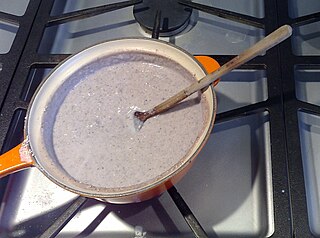 W
WAtole, also known as atolli and atol de elote, is a traditional hot corn- and masa-based beverage of Mesoamerican origin. Chocolate atole is known as champurrado or atole. It typically accompanies tamales, and is very popular during Day of the Dead and Las Posadas.
 W
WBrenntar or Habermus or Schwarzer Brei was a Swabian staple foodstuff, particularly prominent in the Swabian Jura and in the Allgäu. It is made of roasted flour, usually spelt flour or oat flour. This kiln-dried flour is called Musmehl. It is usually cooked like a porridge with water and milk.
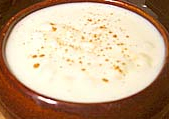 W
WCanjica, mugunzá or mungunzá is a Brazilian sweet dish, associated with winter festivals, which in Brazil is in June.
 W
WChamporado or tsampurado is a sweet chocolate rice porridge in Philippine cuisine.
 W
WCream of Wheat is an American brand of farina, a type of breakfast porridge mix made from wheat semolina. It looks similar to grits, but is smoother in texture since it is made with ground wheat kernels instead of ground corn. It was first manufactured in the United States in 1893 by wheat millers in Grand Forks, North Dakota. The product made its debut at the 1893 World's Columbian Exposition in Chicago, Illinois. Before January 2007, Cream of Wheat was a Nabisco brand made by Kraft Foods. In January 2007, B&G Foods acquired the brand and all rights to market the cereal. "Cream of Wheat" is a registered trademark.
 W
WFarina is the name given to a form of milled wheat in the United States of America. The word "farina" is Latin, meaning meal or flour and the Italian and Catalan word for flour. It is made from wheat middlings: the germ and endosperm of the grain, which are milled to a fine consistency and then sifted.
 W
WFrumenty was a popular dish in Western European medieval cuisine. It is a porridge, a thick boiled grain dish—hence its name, which derives from the Latin word frumentum, "grain". It was usually made with cracked wheat boiled with either milk or broth and was a peasant staple. More luxurious recipes include eggs, almonds, currants, sugar, saffron and orange flower water. Frumenty was served with meat as a pottage, traditionally with venison or even porpoise. It was also frequently used as a subtlety, a dish between courses at a banquet.
 W
WGachas is an ancestral basic dish from central and southern Spain. Its main ingredients are flour, water, olive oil, garlic, paprika and salt.
 W
WGenfo or Ga’at is a stiff porridge-like substance that is normally formed into a round shape with a hole in the middle for the dipping sauce, a mixture of butter and red peppers, or pulses such as sunflower, seed, nut and flax.
 W
WGrits are a porridge made from boiled cornmeal. Hominy grits are a type of grits made from hominy – corn that has been treated with an alkali in a process called nixtamalization, with the pericarp removed. Grits are often served with other flavorings as a breakfast dish. Grits can be either savory or sweet, with savory seasonings being more common. The dish originated in the Southern United States but is now available nationwide. Grits are popular as the dinner entrée shrimp and grits, served primarily in the South. Grits should not be confused with boiled ground corn, hasty pudding, mush, or polenta, as these have differing ingredients.
 W
WGroats are the hulled kernels of various cereal grains, such as oat, wheat, rye, and barley. Groats are whole grains that include the cereal germ and fiber-rich bran portion of the grain, as well as the endosperm.
 W
WGruel is a food consisting of some type of cereal—such as ground oats, wheat, rye or rice—boiled in water or milk. It is a thinner version of porridge that may be more often drunk rather than eaten and may not need to be cooked. Historically, gruel has been a staple of the Western diet, especially for peasants. Gruel is often made from millet, hemp, barley, or, in hard times, from chestnut flour or even the less bitter acorns of some oaks. Gruel is also a colloquial expression for any watery or liquidy food of unknown character, e.g., pea soup.
 W
WGuryev porridge is a Russian sweet porridge (kasha) prepared from semolina and milk with the addition of candied nuts, honey and dried fruits.
 W
WHarees, Jareesh, boko boko, or harisa is a dish of boiled, cracked, or coarsely-ground wheat, mixed with meat and seasoned. Its consistency varies between a porridge and a dumpling. Harees is a popular dish known in Arab states of the Persian Gulf, especially in the month of Ramadan, while harisa is an Armenian dish from the Ararat plain.
 W
WHelmipuuro (Finnish) is a type of porridge traditional in Finland. The porridge is made from monodisperse grains of potato starch that are swelled in boiling milk into translucent "pearls" of about 5 mm in diameter, thus the name helmipuuro. As with other porridges, it can be eaten as is or flavored with butter, kissel, berries, jam or sugar.
 W
WKačamak is a kind of maize porridge made in the Balkans. Its name is derived from the Turkish word kaçamak, meaning escapade. It is also known as bakrdan (бакрдан) in North Macedonia.
 W
WIn the English language, kasha usually refers to pseudocereal buckwheat or its culinary preparations. In various East-Central and Eastern European countries, kasha can apply to any kind of cooked grain. It can be baked but most often is boiled, either in water or milk, and therefore the term coincides with the English definition of porridge, but the word can also refer to the grain before preparation, which corresponds to the definition of groats. This understanding of kasha concerns mainly Belarus (каша), the Czech Republic (kaše), Lithuania (košė), Poland (kasza), Russia (каша), Slovakia (kaša) and Ukraine (каша), where the term, besides buckwheat, can apply to wheat, barley, oats, millet and rye. Kashas have been an important element of Slavic diet for at least one thousand years.
 W
WKoliva, also spelled kollyva, kollyba or colivă, is a dish based on boiled wheat that is used liturgically in the Eastern Orthodox Church for commemorations of the dead.
 W
WKonkonte is a Ghanaian dish usually eaten with a soups made from palm nut or groundnuts. It is popular in west African countries such as Nigeria and is also eaten in the Caribbean.
 W
WKoozh is the Tamil name for a porridge made from millet. It is commonly sold by street vendors in Tamil Nadu.
 W
WLapa (Turkish) or lapas is a kind of rice porridge or gruel eaten in the Balkans, Levant, and Middle East. It is made of just rice, water, and salt and has the consistency of a thick soup.
 W
WMacroom Oatmeal is a traditional stone-ground Irish oatmeal produced in Macroom, County Cork, Ireland, at Walton's Mill, the last surviving stone mill in Ireland. It was taken aboard Slow Food's Ark of Taste in 2011, as of 2019 one of twelve Irish foods selected for the ark.
 W
WMămăligă is a porridge made out of yellow maize flour, traditional in Romania, Moldova and West Ukraine. Preparing the traditional dish is also continued by Poles from Lviv whose families were resettled in the Recovered Territories after World War II. In Italy, Portugal, Switzerland, Slovenia, Croatia and many other countries, this dish is known as polenta, while in Georgia, it is called ღომი (gomi).
 W
WMaypo is a brand of instant maple-flavored oatmeal cereal. It was originally manufactured by Maltex Co. and is now owned by Homestat Farm, Ltd. It was best known for its television commercials with the catchphrase, "I Want My Maypo" by Marky Maypo.
 W
WMazamorra is the name for numerous traditional dishes from Iberian Peninsula and Latin America.
 W
WMush is a type of cornmeal pudding which is usually boiled in water or milk. It is often allowed to set, or gel into a semisolid, then cut into flat squares or rectangles, and pan fried. Usage is especially common in the eastern and southeastern United States. It is customary in the midwestern United States to eat it with maple syrup or molasses. In Eastern Europe, milk is poured over the meal once served and cooled down, rather than being boiled in it. Cornmeal mush is often consumed in Latin America and Africa.
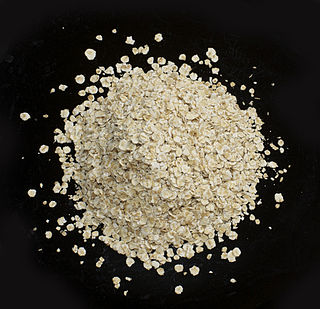 W
WOatmeal is a type of coarse flour made of hulled oat grains (groats) that have either been milled (ground) or steel-cut. Ground oats are also called "white oats". Steel-cut oats are known as "coarse oatmeal", "Irish oatmeal" or "pinhead oats". Rolled oats can be either thick or thin, and may be categorized as "old-fashioned", "quick", or "instant", depending on the cooking time, which is shortened by the size of the oats, precooking, and sometimes the addition of enzymes.
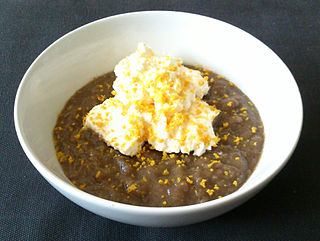 W
WØllebrød is a traditional Danish dish. It is a porridge made of rugbrød and beer, typically hvidtøl, and it is a thrifty dish.
 W
WPapeda, or bubur sagu, is sago congee, a staple food of native people in Maluku Islands and Western New Guinea. It is commonly found in eastern Indonesia, as the counterpart of central and western Indonesian cuisines that favour rice as their staple food.
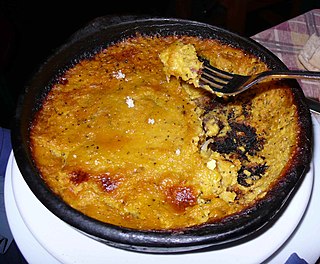 W
WPastel de choclo is a Chilean dish based on sweetcorn or choclo. It is also similar to pastel de elote, found in Mexican cuisine, and to the English corn pudding. The filling usually contains ground beef, chicken, raisins, black olives, onions or slices of hard boiled egg.
 W
WPease pudding, also known as pease porridge, is a savoury pudding dish made of boiled legumes, typically split yellow peas, with water, salt, and spices, and often cooked with a bacon or ham joint. A common dish in the north-east of England, it is consumed to a lesser extent in the rest of Britain, as well as in other regions worldwide.
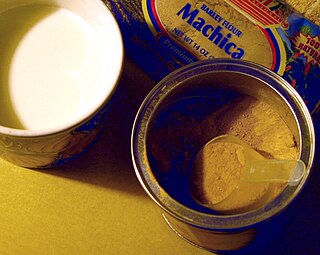 W
WPinole, also called pinol or pinolillo, is roasted ground maize, which is then mixed with a combination of cocoa, agave, cinnamon, chia seeds, vanilla, or other spices. The resulting powder is then used as a nutrient-dense ingredient to make different foods, such as cereals, baked goods, tortillas, and beverages. The name comes from the Nahuatl word pinolli, meaning cornmeal. Today, pinole is generally made by hand using wood-burning adobe ovens and a stone and pestle, and is still consumed in certain, often rural, parts of Latin America. Pinole is considered the national beverage of Nicaragua and Honduras.
 W
WPoi or Popoi is a traditional staple food in the Polynesian diet, made from starchy vegetables, usually breadfruit, taro or plantain.
 W
WPolenta is a dish of boiled cornmeal that was historically made from other grains. It may be served as a hot porridge, or it may be allowed to cool and solidify into a loaf that can be baked, fried, or grilled.
 W
WRice pudding is a dish made from rice mixed with water or milk and other ingredients such as cinnamon, vanilla and raisins.
 W
WRødgrød, Rote Grütze, or Rode Grütt, meaning "red groats", is a sweet fruit dish from Denmark and Northern Germany. The name of the dish in Danish features many of the elements that make Danish pronunciation difficult for non-native speakers, so rødgrød med fløde, literally "red porridge with cream", is a commonly used shibboleth since the early 1900s.
 W
WRolled oats are a type of lightly processed whole-grain food. Traditionally, they are made from oat groats that have been dehusked and steamed, before being rolled into flat flakes under heavy rollers and then stabilized by being lightly toasted.
 W
WRømmegrøt, also known as rømmegraut (Nynorsk) and römmegröt (Swedish), is a Norwegian porridge made with sour cream, whole milk, wheat flour, butter, and salt.
 W
WRubaboo is a common stew or porridge consumed by coureurs des bois and voyageurs and Métis people of North America. This dish is traditionally made of peas and/ or corn, with grease and a thickening agent that makes up the base of the stew. Pemmican and maple sugar were also commonly added to the mixture. Rubaboo that is made by the Plains Metis is often made with pemmican, rabbit, prairie chicken or sage hen and a wide variety of wild vegetables such as wild parsnip onion, turnip, and asparagus that can all be added to the food with preference. The thickened mixture was later re-served as “rowschow” (re-chaud). Sometimes, It is occasionally spelled Rubbaboo. Other sources describe it as consisting primarily of boiled pemmican, with thickening agents added when available.
 W
WSemolina pudding or semolina porridge is a porridge-type pudding made from semolina, which is cooked with milk, or a mixture of milk and water. It is often served with sugar, cocoa powder, cinnamon, raisins, fruit, or syrup. A similar consistency to rice pudding can also be made by using more semolina and by baking, rather than boiling.
 W
WSteel-cut oats (US), also called pinhead oats, coarse oatmeal (UK), or Irish oatmeal are groats of whole oats which have been chopped into two or three pinhead-sized pieces. The pieces can then be sold, or processed further to make rolled oat flakes, of smaller size than flakes of whole groats. Steel-cutting produces oatmeal with a chewier and coarser texture than other processes.
 W
WTinutuan, also known as bubur manado or Manadonese porridge is a specialty of the Manado cuisine and a popular breakfast food in the city of Manado and the surrounding province of North Sulawesi, Indonesia. Tinutuan is a congee made from rice, pumpkin and sweet potato or cassava cooked up into a pulp, which is then mixed with corn kernels and various leafy vegetables such as kangkung, kemangi, melinjo, and bayam (amaranth). Finally it is served with many toppings that may include fried shallots, fried tofu, spring onions, leeks, coriander, chili, condiments like sambal and dabu-dabu, and smoked or salted fish, usually skipjack tuna, anchovies, or nike.
 W
WTsampa or Tsamba is a Tibetan and Himalayan staple foodstuff, particularly prominent in the central part of the region. It is glutinous meal made from roasted flour, usually barley flour and sometimes also wheat flour. It is usually mixed with the salty Tibetan butter tea. It is also eaten in Turkestan and Mongolia, where it is known as zamba.
 W
WTuwon shinkafa is a type of Nigerian and Niger dish from Niger and the northern part of Nigeria. It is a thick pudding prepared from a local rice or Maize or millet that is soft and sticky, and is usually served with different types of soups like Miyan kuka, Miyan kubewa, Miyan taushe.
 W
WUgali, also known as ugali bogobe pap, nsima and nshima, is a type of maize or cassava flour porridge made in Africa. It is also known as ngima, obusuma, obuchima, kimnyet, nshima, mieliepap, phutu, sadza, kwon, gauli, gima, isitshwala, ubugali, umutsima, and other names. Nsima is sometimes made from other flours, such as millet or sorghum flour, and is sometimes mixed with cassava flour. It is cooked in boiling water or milk until it reaches a stiff or firm dough-like consistency.
 W
WUpma, uppumavu or uppittu is a dish originating from the Indian subcontinent, most common in Kerala, Andhra Pradesh, Tamil Nadu,Karnataka, Maharashtrian, Gujarat, Odia and Sri Lankan Tamil breakfast, cooked as a thick porridge from dry-roasted semolina or coarse rice flour. Various seasonings and/or vegetables are often added during the cooking, depending on individual preferences. Today it is popular in most parts of India and is prepared in various ways.
 W
WVispipuuro or vispgröt/klappgröt/klappkräm is a sweet, wheat semolina (manna) dessert porridge made with berries, usually lingonberries. It is eaten in both Finland and Sweden. The semolina is cooked with the berries and also some kind of sweetener. Note that in Sweden, it's usually made by adding lingonberry cordial to the water, in which the semolina is cooked, as the texture is supposed to be smooth, so you don't want little bits of berries in the porridge. After the mixture has cooled down, the porridge is vigorously whipped to a light, mousse-like consistency. Alternatively, the pot the porridge was made in, can be put in the kitchen sink, partially filled with water and whisk it in there, so it cools down while being whisked with a hand mixer. The dessert is usually served with milk and optionally sugar. Other berries and fruit that can be used are redcurrants, cranberries, apricots, gooseberries and strawberries.
 W
WWheatena is an American high-fiber, toasted-wheat cereal that originated on Mulberry Street in New York City, New York, circa 1879, when a small bakery owner began roasting whole wheat, grinding it, and packaging it for sale under this brand name.
 W
WThe World Porridge Making Championship has been running since 1994, giving a main prize of the "Golden Spurtle" trophy and the title "World Porridge Making Champion" for the best traditional porridge made with oatmeal, water and salt. A prize is also awarded for the best "Speciality" porridge which again is made with oatmeal and contenders can add their own ingredients. The competition takes place at the village hall in Carrbridge, in the Cairngorms National Park, Scotland. and is run by volunteers on behalf of the Carrbridge Community Council. It has taken place alongside World Porridge Day since 2009. The 2019 competition was held on Saturday 12 October.
 W
WXerém or Xarém is an African-Brazilian typical dish, from Cape Verde and Brazil, and is also eaten in Portugal. It is a mash made with corn flour combined with traditional ingredients from each region where it is prepared.